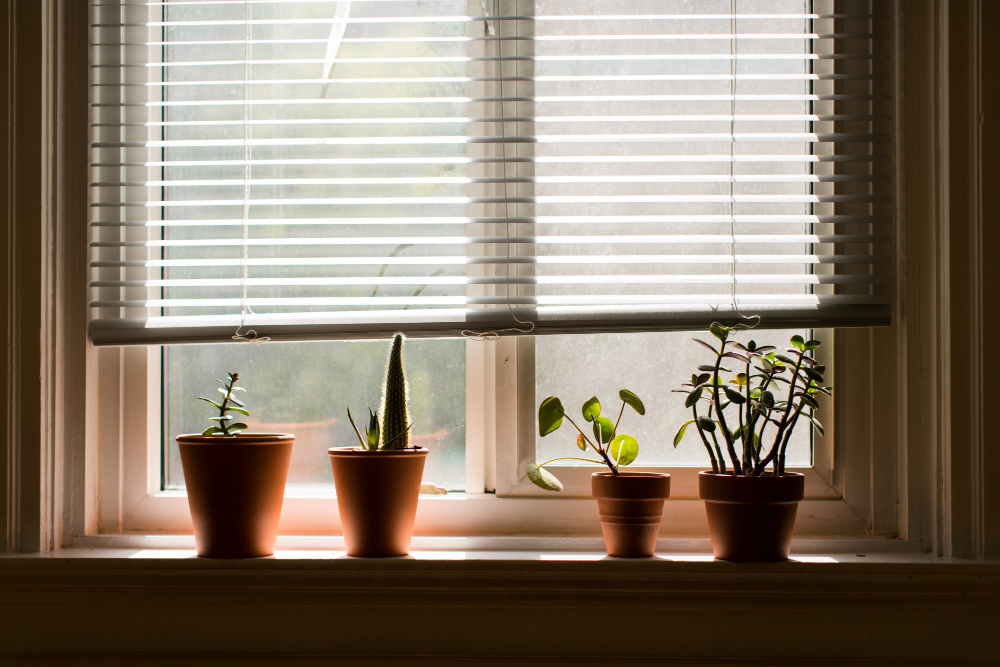Blinds vs Shades – What’s Really the Difference?
Let’s be honest: choosing the right window treatments is a lot trickier than it seems, right? We can’t tell you how many times we’ve heard people ask, “What’s the difference between blinds and shades?”
(It’s probably one of the top five window treatment questions out there!) If you’ve ever walked into a home improvement store or scrolled endless websites and felt overwhelmed by all the lingo—don’t worry. You’re definitely not alone.
Here’s the thing: blinds and shades might sound interchangeable, but they’re actually quite different. And those differences matter. Pick the wrong one, and you could end up with a room that’s either way too bright, totally lacking privacy, or just… not your style at all. The truth is, most people don’t really know what separates the two. So they end up going with whatever looks good in the moment, only to regret it later when the sun’s blinding them every morning (been there, done that!).
But don’t stress. By the end of this article, you’ll know exactly what makes blinds and shades unique—their benefits, drawbacks, best use cases, and how to choose what fits your lifestyle. We’ll dig into real-life examples, share some surprising stats, and give you actionable tips you can use right away. Whether you’re after the modern look of sleek blinds or the cozy vibe of soft shades, you’ll feel confident making the right call. Let’s clear up the confusion once and for all.
Blinds vs Shades: The Core Differences Explained
Before we dive into the nitty-gritty details, let’s set the record straight on what each term actually means. We’ve noticed a lot of companies use “blinds” as a catch-all term, but trust us, there’s a pretty big difference between blinds and shades. Understanding this is the first step to getting your window treatments right.

What Are Blinds?
Blinds are made of individual slats—think wood, faux wood, aluminum, or even vinyl—that can be tilted open or closed. You’ve probably seen Venetian blinds, vertical blinds, or mini-blinds in offices and homes. The magic of blinds is all in the way you can adjust the slats to control light and privacy. Want to let in a little light without giving your neighbors a peek inside? Just angle the slats. Need complete privacy? Close them tight.
Materials: Wood, faux wood, aluminum, vinyl, bamboo
Operation: Corded, cordless, or motorized (great for hard-to-reach windows)
Control: Slats tilt for adjustable light control
Blinds are super versatile and come in a ton of colors and finishes. But they do have their quirks (hello, dust magnets!).
What Are Shades?
Shades, on the other hand, are made from a single piece of fabric or material that rolls, folds, or stacks up when you raise them. No slats, just smooth coverage. Picture classic roller shades, Roman shades, or honeycomb/cellular shades. These give you a softer look and are usually better for blocking out light entirely or adding a cozy feel to a room.
Materials: Fabric, woven wood, synthetic blends, bamboo
Operation: Corded, cordless, motorized (perfect for modern homes or child safety)
Control: Up or down—no tilting slats
Because shades are solid, you don’t get the same adjustable light control as blinds, but you do get more options for blackout, light filtering, and energy efficiency.
Visual Comparison: Blinds vs Shades
Blinds: Structured, angular, more “hard” look (think crisp and modern)
Shades: Soft, flowing, adds warmth or coziness (great for bedrooms or living rooms)
So, if you’re still picturing both as that tangled mess over your grandma’s kitchen sink, think again—window treatments have come a long way!
The Benefits of Blinds: Why Choose Them?
Let’s dig into the juicy stuff—why would you pick blinds over shades? It’s not just about aesthetics (though that’s a big part). Blinds bring a lot to the table, especially if you want versatility and control.
Precise Light & Privacy Control
This is where blinds really shine. You can tilt the slats to let in just the right amount of light, or close them completely for privacy. Need to work from home without the sun glaring on your screen? Tilt the blinds. Want to enjoy the sunset without feeling like you’re on display? Easy. According to a recent Houzz survey, over 60% of homeowners said adjustable light control was their #1 reason for choosing blinds over shades.
Durability & Longevity
Blinds—especially wood or faux wood—are built to last. I’ve had a set in my own kitchen for nearly a decade, and aside from the occasional dusting (not my favorite chore), they’re still going strong. Materials like aluminum and vinyl are also moisture-resistant, which makes them ideal for bathrooms or kitchens where humidity can be an issue.
Resist fading and warping in sunlight (especially faux wood and aluminum)
Hold up well to daily use—great for families or rental properties
Easy to repair—broken slat? Replace just that, not the whole thing
Style & Customization Options
The style game is strong with blinds. Whether you want a classic wood look, sleek metal, or bold colors, there’s something for every taste. And with modern cordless and motorized options, they’re safer for kids and pets (no more tangled cords!).
Venetian blinds for a traditional vibe
Vertical blinds for large patio doors or wide windows
Mini blinds for budget-friendly options in offices or rentals
Easy Maintenance
Look, no one really enjoys cleaning window treatments. But blinds are about as low-fuss as it gets—just a quick dust with a microfiber cloth or a swipe with the vacuum brush. For sticky messes (hello, kitchen splatters), a damp sponge usually does the trick.
When Blinds Might Not Be Ideal
Of course, blinds aren’t perfect for every scenario. If you need total blackout for a media room or crave a super-soft, layered look, shades might be the better pick. Plus, blinds can be noisy if you’re opening and closing them a lot, and (let’s be honest) they do love to collect dust.

The Benefits of Shades: Why Go with Shades?
So, what about shades? If you’re after comfort, style, and serious versatility, shades have a lot to offer. They’re not just for blocking out light—though they do that exceptionally well.
Softness & Style Galore
Shades bring instant warmth and texture to a room. You get tons of fabric choices, patterns, and colors. Want blackout for your bedroom? There’s a shade for that. Looking for light filtering with privacy? You got it. I’ve helped plenty of clients pick Roman shades for their living rooms, and the transformation is always jaw-dropping—suddenly the space feels inviting and put together.
Roman shades for a luxurious, draped look
Roller shades for minimalist, modern spaces
Cellular (honeycomb) shades for a sleek, energy-efficient vibe
Light Filtering & Blackout Options
One of the biggest advantages of shades is the range of light control options. You can go from sheer (letting in soft, diffused light) to full blackout (perfect for night-shift workers or movie buffs). Recent data from the Window Covering Safety Council shows that over 70% of parents prefer cordless blackout shades for nurseries and kids’ rooms.
Energy Efficiency
Here’s something a lot of people overlook: shades, especially cellular shades, can actually help insulate your home. Those little honeycomb pockets trap air and reduce heat transfer, which means you could save up to 25% on energy bills (according to the U.S. Department of Energy). That’s not just good for your wallet—it’s good for the planet, too.
Great for Oddly-Shaped Windows
Got a tricky arch window or a skylight? Shades are usually easier to custom-fit for non-standard shapes. Plus, motorized options make it a breeze to operate hard-to-reach shades with the push of a button (or even a voice command).
Potential Downsides
Shades do have some cons. Unlike blinds, you can’t adjust the light in small increments—it’s all or nothing. And while many fabrics are washable, some delicate materials can be hard to clean if you have messy pets or kids with sticky fingers.
Comparing Blinds and Shades: Which Is Right for You?
Okay, so now you know the basics, but how do you actually choose between blinds and shades? Here’s where it gets personal—because the right answer depends on your needs, your space, and, honestly, your personal taste.
Light and Privacy Needs
Need precise light control? Go with blinds. The adjustable slats let you fine-tune the amount of sunlight and privacy.
Need full blackout or soft, filtered light? Shades are your friend, especially blackout or cellular varieties.
If you’re a shift worker (or just hate waking up with the sun), blackout shades in the bedroom are a game changer. But for a home office or living area where you want to tweak the light throughout the day, blinds make more sense.
Style & Aesthetic Preferences
Modern, clean lines? Blinds (especially aluminum or wood) look sharp.
Cozy, layered, or luxurious? Shades (like Roman or fabric roller) add softness and depth.
Look at your existing decor and ask yourself: Do you like structured, geometric styles, or do you favor a softer, fabric-driven aesthetic? There’s no wrong answer—just what feels like home to you.
Budget Considerations
Standard vinyl blinds are typically the most budget-friendly option—great for rentals or secondary spaces.
Custom shades, designer fabrics, or motorization can add up fast, but the impact is worth it if you’re investing in your forever home.
On average, HomeAdvisor reports installation costs for blinds start around $700 for a full house, while shades can range from $900 to $2,500 depending on customization. But remember, you get what you pay for—quality materials and professional installation make a huge difference in longevity and appearance.
Maintenance & Longevity
If you’re pressed for time (or just hate cleaning), blinds are usually easier to dust or wipe down. Shades, especially those with delicate fabrics, may require occasional spot cleaning or professional cleaning. And if you have pets or young kids, consider durability and ease of use—cordless or motorized options are safer and last longer.
Room-by-Room Recommendations
Kitchen & Bath: Faux wood or aluminum blinds (moisture-resistant, easy to clean)
Living Room: Roman shades or patterned roller shades (add warmth and style)
Bedroom: Blackout shades for sleep or wood blinds for classic style
Home Office: Vertical or mini blinds (control glare, professional look)
Of course, don’t be afraid to mix and match! I’ve seen some stunning spaces with blinds in communal areas and cozy shades in bedrooms.
Key Takeaways: Making the Right Choice for Your Windows
Blinds offer precise control over light and privacy with adjustable slats—ideal for kitchens, offices, and living rooms.
Shades provide softness, style, and energy efficiency, especially with blackout or cellular varieties—perfect for bedrooms and nurseries.
Consider your lifestyle: Blinds are durable and easy to clean; shades add warmth and can help lower energy bills.
Budget matters: Blinds are generally more affordable; custom shades and motorized options can increase costs.
Safety first: Opt for cordless or motorized options if you have kids or pets.
Match the treatment to the room: Use blinds in high-traffic, moisture-prone areas; shades in spaces where comfort and style are key.
Don’t be afraid to mix and match throughout your home for the best of both worlds.

Conclusion: Your Next Steps for Beautiful, Functional Windows
In summary, understanding the difference between blinds and shades is the key to making a choice you’ll love for years. Blinds give you that unbeatable control and durability, while shades can transform a space with their warmth, softness, and energy-saving perks. The right window treatment isn’t just about looks—it’s about how you live, what you need, and the vibe you want in each room.
So, take a walk through your space. Think about your light, privacy, and style needs. Try imagining how each option would feel on a lazy Sunday morning or a busy weekday. Need some help? Reach out to the Pro Shades and Blinds team—we’re here to walk you through samples, give you honest advice, and make sure your windows look (and work) better than ever. Don’t settle for “just okay” window treatments—choose what truly fits your life and style.
